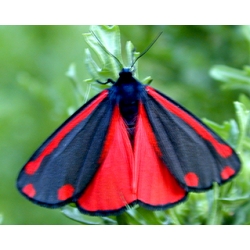- Current EGGS and LARVAE (54)
- EXOTIC BUTTERFLY PUPAE (11)
- MARKET STALL Everything a BARGAIN! (22)
- XXP super fast EXPRESS COURIER DELIVERY (2)
- CURRENT PUPAE - Chrysalides and cocoons (45)
- SILKWORM EGGS and Silkworms (6)
- SPRING and SUMMER EGGS and LARVAE Order now for supply in season (73)
- SPRING and SUMMER PUPAE You can order these NOW in advance (25)
- GIFT SUGGESTIONS (29)
- WINTER PUPAE for breeding in the following season (30)
- CAGES (10)
- PHASMIDS Leaf & Stick Insects, Mantids and more (2)
- SCHOOLS Recommended Livestock (14)
- SLEEVES for REARING LARVAE (7)
- PLASTIC REARING CONTAINERS (2)
- EQUIPMENT (29)
- MOTH TRAPS (7)
- NETTING (3)
- BOOKS (39)
- CHARTS (21)
- SPECIMENS for collectors (151)
- SILK Yarn, Fibres, Silkworm eggs (7)
Cinnabar Moth Hipocrita jacobaeae pupae
Once an extremely common British Moth, less common over most of Europe, but over the last 10 years there has been a marked decline in numbers. The summer of 2016 brought a reversal of this decline and we have a fine stock of pupae available, as a result of breeding.
The larvae feed on Groundsel and Ragwort Senecio. The larvae are ringed in bright orange and black, nature's warning colours, and they absorb chemicals from the foodplant that adversely affect predators who ignore the warning. Ragwort is a mis-understood plant that provides an abundance of nectar to bees, butterflies and other insects. There is evidence that Ragwort plants that are pulled up and left to dry, can be detrimental to cattle and horses if they eat the dried plants. Animals can be seen grazing safely in fields containing growing green plants. There is nothing to be gained from pulling up Ragwort plants, because they are biennials that flower and die in the same year. So a patch of Ragwort can provide valuable nectar to thousands of wild insects, and be host to Cinnabar larvae and, job completed, it dies at the end of summer.
The Cinnabar moth flies by day, more than by night, and is protected from predators, by the very striking colours of charcoal and scarlet, and bitter-tasting chemicals derived from the larval foodplant, enabling the moth to display its bright colours, yet not be attacked by predators.
Cinnabar larvae can be raised in sleeves on growing Ragwort. We find the sleeves fitted with a zip are particularly successful. When the larvae are large, if you put in the sleeve several handfuls of springy wood shavings or dried leaf litter, they will form thin silken cocoons in which to pupate.
Could you help to spread this colourful day-flying moth again in your area?
Store pupae cool for the winter, even in a fridge, loose in a plastic box, without any padding. In May lay them out in an emerging cage and wait for the moths to emerge.












